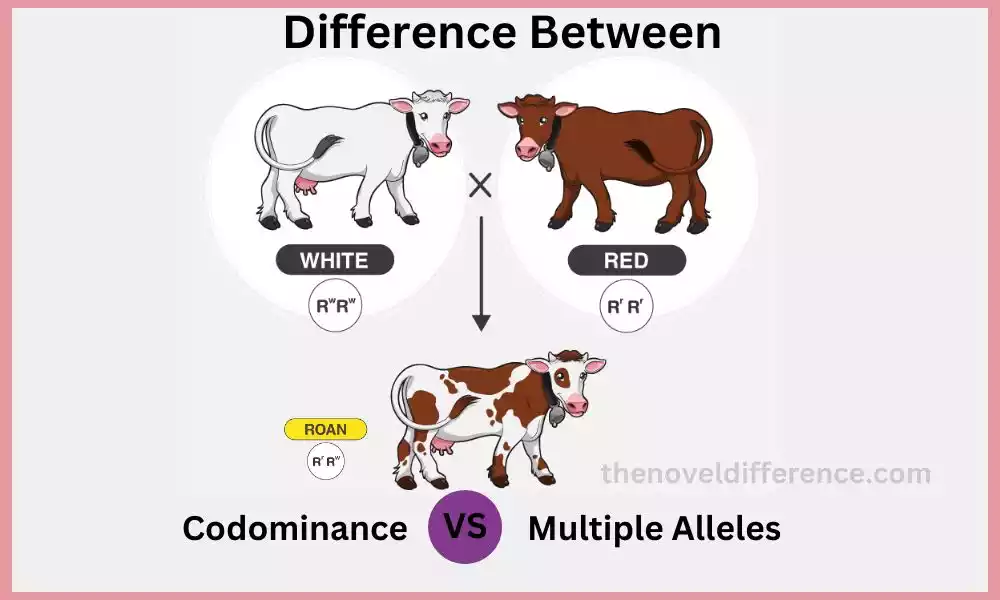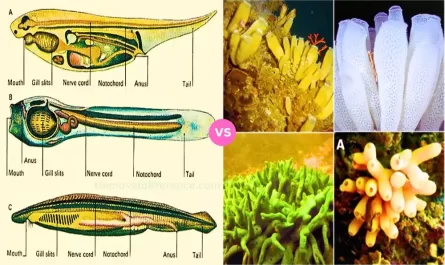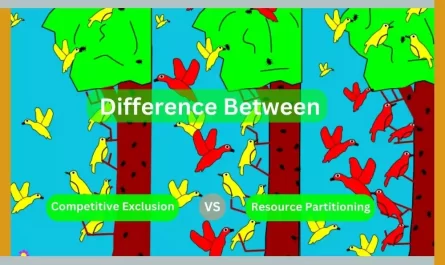Inheritance is a fundamental concept in biology, and it refers to the passing down of traits from parents to offspring. In genetics, traits are determined by genes, which are units of DNA that code for specific proteins. A gene can have different versions or alleles, that may result in variations of the same trait.
Codominance and multiple alleles are two concepts that describe the inheritance of traits in different ways. Although they are often confused, they are distinct concepts that play a crucial role in genetics. In this article, we will examine the differences between codominance and multiple alleles, and how they affect inheritance patterns.
The Marvelous World of Genetics
In the vast landscape of biology, inheritance is the cornerstone. It’s all about traits – those unique characteristics that make us who we are. And at the heart of it all are genes, little segments of our DNA that hold the secrets to these traits. But genes are not simple; they come in different flavors called alleles, each capable of giving a trait its own unique twist.
Codominance and multiple alleles are like hidden treasures within the genetic code. They are often confused, but they hold distinct keys to understanding how traits are passed from one generation to the next. In this exciting adventure, we will set out to unravel the differences between codominance and multiple alleles and see how they shape the fascinating world of genetics.
Why Knowing the Difference Matters
Imagine you’re a genetic detective with a magnifying glass. Your mission is to decipher the code hidden in DNA and unveil the secrets of inherited traits. To do this, you need to know the difference between codominance and multiple alleles because:
- Accurate Interpretation of Genetic Clues: Knowing these concepts helps you decipher the genetic data correctly. It’s like reading a genetic map and understanding how the terrain of traits unfolds.
- Deepening Your Genetic Knowledge: Codominance and multiple alleles are the building blocks of genetic understanding. Grasping these distinctions helps you explore the intricate ways genes are inherited and how they shape the world around us.
- Aiding in Genetic Counseling and Diagnosis: As a genetic detective, you’ll often work with families to guide them through their genetic mysteries. Knowing the secrets of codominance and multiple alleles allows you to assess risks, predict outcomes, and provide invaluable guidance.
- Unveiling the Evolutionary Tale: Multiple alleles are the architects of genetic diversity, shaping the evolutionary path of species. Understanding them helps you decipher how life’s tapestry evolves and changes over time.
- Applied Genetic Adventures: In the world of selective breeding and biotechnology, knowing the difference between codominance and multiple alleles is like holding a treasure map. It guides you to desired traits in plants and animals or helps you create new genetic marvels.
By unraveling the distinctions between codominance and multiple alleles, you unlock the secrets of genetics. It’s like having a superpower that enables you to interpret genetic data, deepen your genetic knowledge, assist in genetic counseling and diagnosis, uncover evolutionary tales, and embark on exciting genetic adventures.
Codominance Unveiled
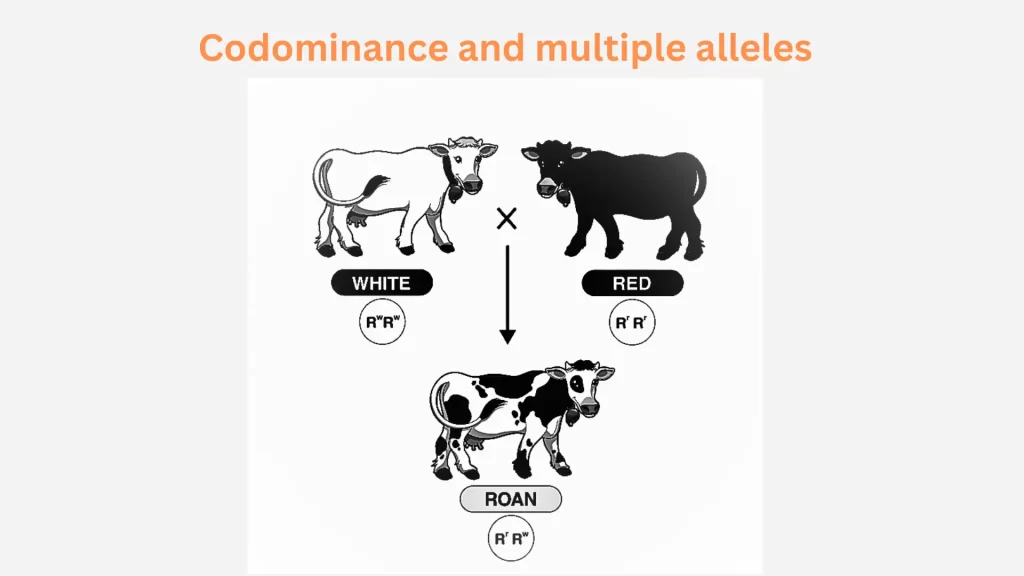
Codominance is like a spectacular show in a genetic circus where two different alleles of a gene take center stage and shine equally bright. It’s the opposite of complete dominance, where one allele takes the spotlight and overshadows the other. In codominance, both alleles perform without holding anything back, each contributing to the grand finale.
No Dominance, No Blending
In the world of codominance, there’s no dominance or blending. It’s like having two soloists singing their hearts out on the same stage. They don’t mix their voices; they each have their distinct tunes. The result? A harmonious duet where both voices are heard loud and clear.
Take, for instance, the ABO blood group system in humans. It’s a prime example of codominance. The gene responsible for blood type has three alleles: A, B, and O. When you have the AO genotype, you don’t get a mix of A and O – you get both the A and O blood types, creating the AB blood type.
Codominance is like a celebration of diversity, where different alleles coexist, each expressing its unique trait. It’s the genetic magic behind some of the most captivating traits we see in the natural world.
How Codominance Stands Apart
Codominance sets itself apart from other genetic inheritance patterns. Unlike complete dominance, where one allele steals the show, and incomplete dominance, where alleles mix and create something new, codominance is the realm of perfect cooperation. Each allele has its role, and they play it to the fullest, creating a genetic masterpiece in the process.
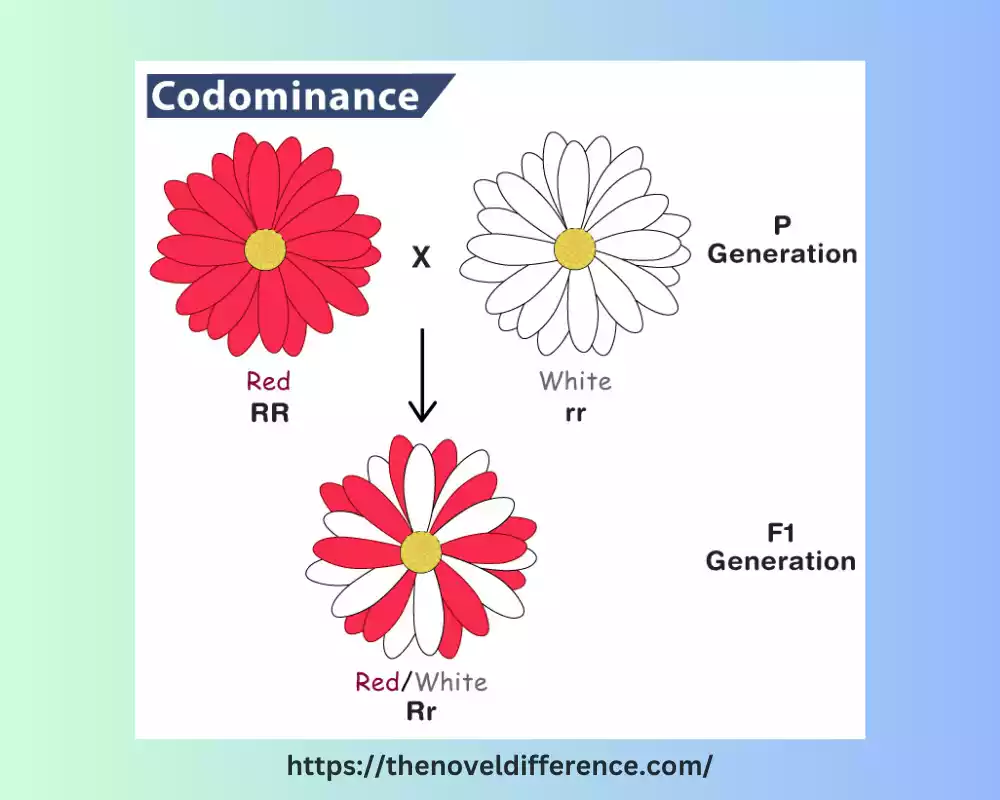
Here are the key differences
1. Codominance vs. Complete dominance:
• in complete dominance, one allele (the dominant allele) masks or suppresses the expression of the other allele (the recessive allele) when they are present together in a heterozygous individual. The dominant allele is fully expressed in the phenotype, while the recessive allele remains hidden.
• in codominance, both alleles are fully expressed in the phenotype of a heterozygous individual. Neither allele is dominant or recessive, and their effects are independent of each other.
2. Codominance vs. Incomplete dominance:
• in incomplete dominance, the phenotype of a heterozygous individual is an intermediate blend or mixture of the phenotypes associated with the two alleles. There is a blending or partial expression of both alleles.
• in codominance, there is no blending or intermediate phenotype. Instead, both alleles are expressed fully and simultaneously in the phenotype, resulting in the distinct expression of each trait associated with the alleles.
3. Codominance and multiple alleles:
• codominance and multiple alleles are related concepts but represent different aspects of genetic inheritance.
• codominance describes the expression of two different alleles in the phenotype of a heterozygous individual.
• multiple alleles refer to the presence of more than two alternative forms of a gene (alleles) in a population. Multiple alleles can contribute to codominant or other types of inheritance patterns.
The key distinction of codominance lies in the simultaneous and independent expression of both alleles in the phenotype, without dominance or blending, setting it apart from complete dominance and incomplete dominance.
Examples of codominant traits in plants and animals
Codominant traits can be observed in various plants and animals.
Here are a few examples:
1. Abo blood group system in humans:
• the abo blood group system is a classic example of codominance in humans.
• the gene responsible for blood type has three alleles: a, b, and o.
• when the a allele is present, it produces the a antigen on the surface of red blood cells, resulting in blood type a.
• when the b allele is present, it produces the b antigen, leading to blood type b.
• if both a and b alleles are present in an individual (genotype ab), both a and b antigens are expressed on the red blood cells, resulting in blood type ab.
2. Coat color in cattle:
• in certain breeds of cattle, coat color inheritance demonstrates codominance.
• for example, in some breeds, the alleles for red coat color (r) and white coat color (w) exhibit codominance.
• heterozygous individuals with genotype rw have a roan coat, expressing both red and white hairs evenly distributed throughout their coat.
3. Feathers in chickens:
• feather color in some chicken breeds also showcases codominance.
• the alleles for black feathers (b) and white feathers (w) exhibit codominance.
• heterozygous individuals with genotype bw have both black and white feathers, resulting in a speckled or “splash” pattern.
4. Flower color in four-o’clock plants:
• four-o’clock plants (mirabilis jalapa) exhibit codominance in flower color inheritance.
• the alleles for red flowers (r) and white flowers (w) are codominant.
• heterozygous individuals with genotype rw produce flowers with both red and white sectors, resulting in a variegated appearance.
These examples illustrate how codominance allows for the simultaneous expression of different alleles, leading to distinct and observable traits in plants and animals.
Definition of multiple alleles
Multiple alleles refer to the presence of more than two alternative forms of a particular gene (alleles) within a population. In a multiple allele system, there are three or more alleles available for a specific gene, although an individual organism can only carry a maximum of two alleles at a given gene locus.
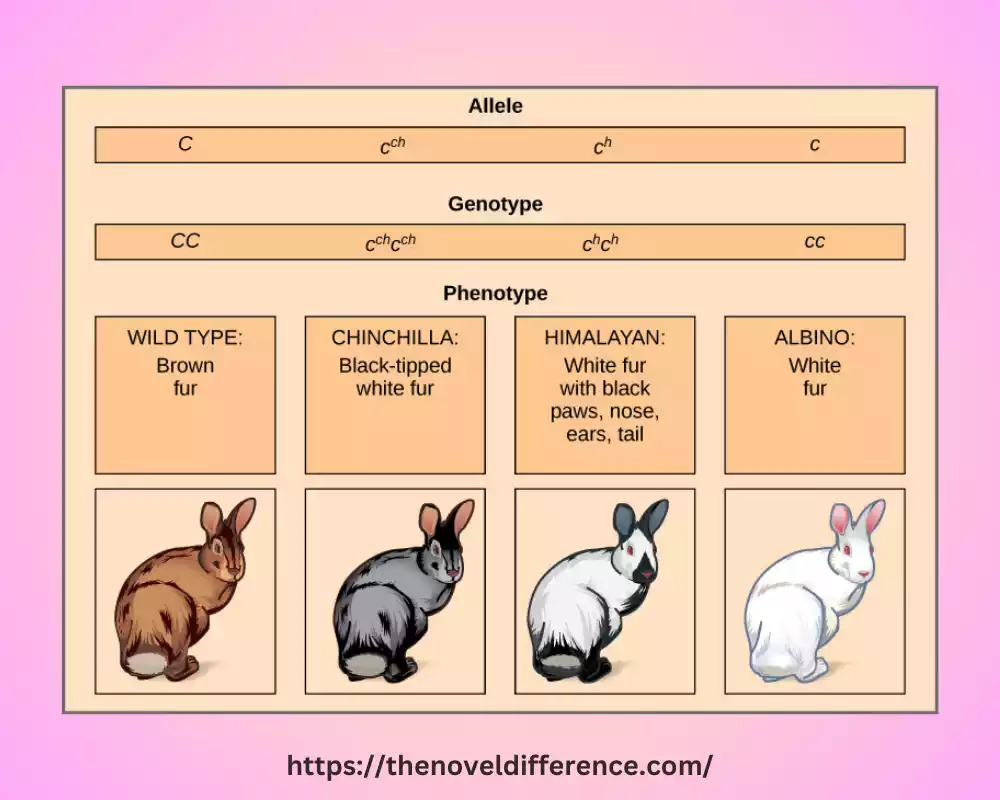
Each allele within a multiple allele system has a distinct nucleotide sequence and can result in different variations of a trait or characteristic. The interactions between these multiple alleles contribute to the wide range of phenotypic variations observed in populations.
It is important to note that in an individual organism, only two alleles are inherited—one from each parent—for a specific gene locus. However, within a larger population, multiple alleles may exist at that locus. For example, in humans, the abo blood group system involves multiple alleles (a, b, and o) at the gene locus controlling blood type.
The presence of multiple alleles increases the potential combinations and variations in traits within a population, contributing to genetic diversity. The expression of these alleles can result in different phenotypic outcomes, ranging from discrete traits to continuous variations. The interactions between multiple alleles can be complex and can involve factors such as dominance, codominance, or incomplete dominance.
Multiple alleles refer to the existence of three or more alternative forms of a gene in a population, with individuals carrying only two alleles at a given gene locus. These multiple alleles contribute to the diverse range of phenotypic variations observed within a population.
Explanation of multiple alleles in a gene pool
Multiple alleles within a gene pool refer to the presence of three or more alternative forms of a specific gene at a particular gene locus among individuals within a population. These alleles are the different variations of a gene that can exist within a population, providing different options for inheritance and phenotypic expression.
The collection of all the alleles present within a population is considered. Each individual organism within the population may carry only two alleles, one inherited from each parent, at a particular gene locus. However, when considering the entire population, there may be multiple alleles available for that gene.
The presence of multiple alleles in a gene pool contributes to genetic diversity. It means that individuals within the population have the potential to inherit different combinations of alleles, leading to a wide range of phenotypic variations.
The frequency of each allele within the gene pool can vary. Some alleles may be more common, while others may be rarer. The relative frequencies of the different alleles determine the genetic composition of the population and influence the probabilities of allele combinations in offspring through mating and reproduction.
The introduction of new alleles into a gene pool can occur through various mechanisms such as mutations, gene flow (migration), or genetic recombination during sexual reproduction. Over time, these factors shape the distribution and frequencies of alleles within the population.
Multiple alleles within a gene pool allow for a broader range of genetic possibilities and can confer advantages or disadvantages to individuals depending on their environment. They contribute to the evolutionary potential of a population by providing the raw material for natural selection to act upon, leading to adaptations and changes in allele frequencies over generations.
Multiple alleles in a gene pool represent the various alternative forms of a gene present within a population. They contribute to the genetic diversity and potential phenotypic variations observed in a population. The frequencies and interactions of these alleles shape the genetic composition and evolutionary dynamics of the population.
Examples of traits controlled by multiple alleles in humans and other organisms
Multiple alleles can control a variety of traits in both humans and other organisms.
Here are some examples:
1. Human abo blood group system:
• the abo blood group system in humans is controlled by multiple alleles.
• the gene responsible for the abo blood type has three alleles: a, b, and o.
• the a allele codes for the a antigen on red blood cells, the b allele codes for the b antigen, and the o allele does not produce any antigen.
• the possible genotypes and corresponding phenotypes are
• aa or ao: blood type a
• bb or bo: blood type b
• ab: blood type ab
• oo: blood type o
2. Human hla genes:
• the human leukocyte antigen (hla) system, which plays a crucial role in the immune response, is controlled by multiple alleles.
• there are many different alleles for hla genes, such as hla-a, hla-b, and hla-drb1.
• the combination of different alleles at these loci determines the unique hla profile of an individual, influencing their immune system’s ability to recognize and respond to foreign substances.
3. Coat color in rabbits:
• the coat color in rabbits is controlled by multiple alleles.
• the gene responsible for coat color has multiple alleles, including those for black (b), chocolate (b), and albino (c).
• the possible combinations of alleles and their corresponding phenotypes are:
• bb: black coat color
• bb: black coat color (heterozygous individuals)
• bb: chocolate coat color
• cc: albino coat color
4. Eye color in drosophila (fruit flies):
• eye color in drosophila is determined by multiple alleles.
• the gene responsible for eye color has multiple alleles, including those for red (w+), white (w), and various shades of intermediate eye color.
• the different combinations of alleles at this locus result in different eye colors observed in fruit flies.
These examples highlight how multiple alleles contribute to the diverse phenotypic variations observed in various traits among humans and other organisms.
The presence of multiple alleles allows for a broader range of genetic possibilities and contributes to the genetic diversity within populations.
Differences between codominance and multiple alleles
Codominance and multiple alleles are distinct concepts in genetics, each describing different aspects of inheritance.
Here are the key differences between codominance and multiple alleles:
1. Nature of gene interactions:
• codominance: codominance refers to the equal and simultaneous expression of two different alleles in the phenotype of a heterozygous individual. Both alleles are fully expressed, without one allele dominating over the other.
• multiple alleles: multiple alleles, on the other hand, describe the existence of three or more alternative forms of a gene (alleles) within a population. Each individual organism carries a maximum of two alleles at a given gene locus, but there are more than two alleles available within the population.
2. Phenotypic outcomes:
• codominance: the phenotype of a heterozygous individual reflects the presence of both alleles. The traits associated with each allele are expressed simultaneously and distinctly, without blending or intermediate phenotypes.
• multiple alleles: with multiple alleles, the phenotypic outcomes can vary depending on the specific interactions between the different alleles. The presence of multiple alleles at a gene locus can lead to a range of phenotypic variations, which may be discrete traits or continuous variations.
3. Examples:
• codominance: examples of codominance include the abo blood group system in humans, where both the a and b alleles are expressed fully in individuals with the ab genotype, resulting in the ab blood type.
• multiple alleles: examples of multiple alleles include the abo blood group system, where three alleles (a, b, and o) exist within the gene pool, or the coat color in rabbits, where multiple alleles (e.G., b, b, c) contribute to the various coat color phenotypes observed.
4. Genetic basis:
• codominance: codominance is primarily concerned with the interaction between two different alleles at a single gene locus.
• multiple alleles: multiple alleles describe the presence of more than two alternative forms of a gene within a population, providing a broader range of genetic variations.
The main difference between codominance and multiple alleles lies in their focus. Codominance describes the equal expression of two different alleles in a heterozygous individual’s phenotype, while multiple alleles refer to the existence of three or more alternative forms of a gene within a population. Codominance focuses on the interaction between two alleles, while multiple alleles encompass a wider range of genetic variations.
Conclusion
The difference between codominance and multiple alleles lies in how they affect the expression of alleles in the phenotype of the organism. Codominance involves the expression of both alleles equally, resulting in a distinct phenotype that is different from either homozygous genotype.
Multiple alleles involve the expression of only two alleles, resulting in a range of phenotypes that can be different from the parent phenotypes. Both inheritance patterns have their own unique characteristics and examples in nature.

